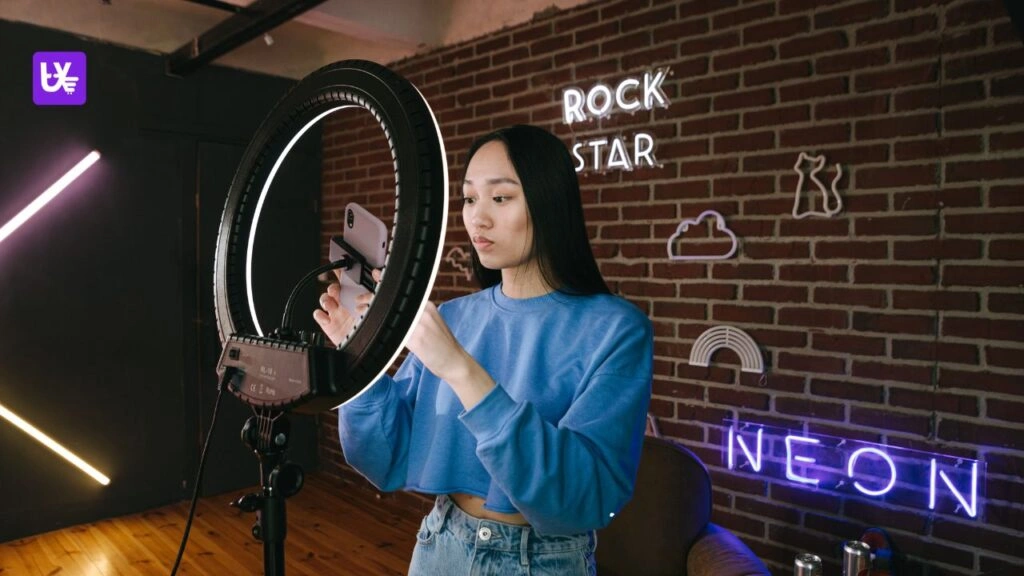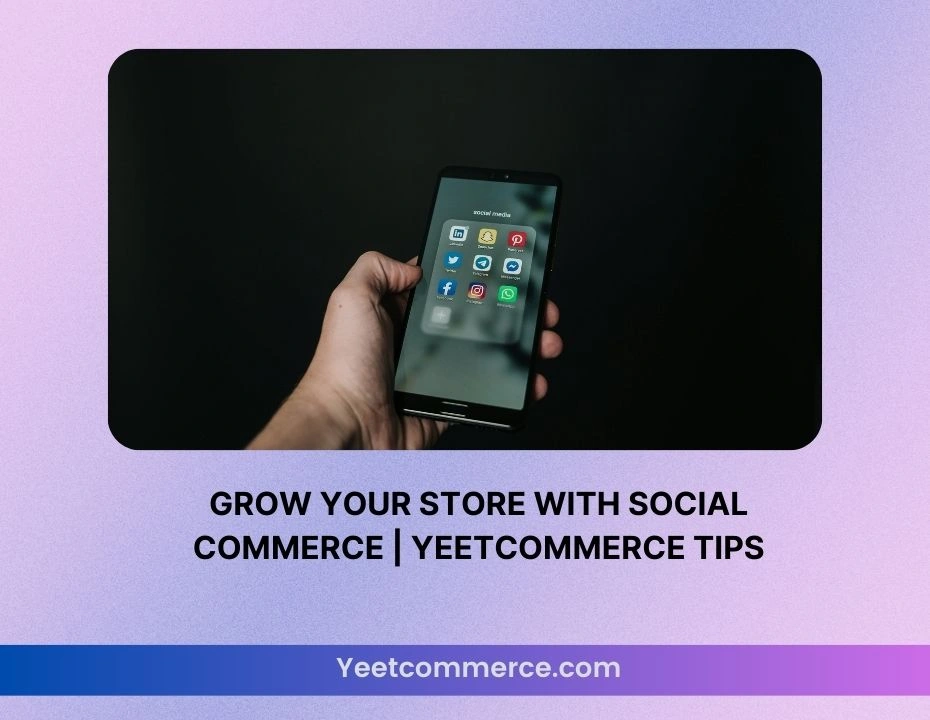Social commerce is the future of online shopping, and this guide will equip you with the tools and strategies to succeed. Discover how to leverage social media platforms to connect with your audience, drive traffic to your store, and boost your sales. From crafting compelling content to mastering social media ads, we’ll cover everything you need to know to dominate the world of social commerce.
Leveraging Social Media Ads: Effective Strategies for Driving Traffic to Your eCommerce Store
When it comes to boosting sales through social commerce, leveraging social media ads can be a game-changer. With the right strategies, you can drive targeted traffic straight to your eCommerce store, leading to increased conversions and, ultimately, higher revenue. Let’s dive into how you can use social media ads effectively to make your Yeetcommerce store the go-to destination for your customers.

Understand Your Audience: The Key to Successful Ads
The first step in any effective ad strategy is understanding your audience. Who are they? What do they want? What social platforms do they use? By answering these questions, you can tailor your ads to meet their needs and preferences. Use tools like Facebook Audience Insights or Instagram Analytics to gather data on your followers’ demographics, interests, and behaviors. This information is crucial in creating ads that resonate with your target audience.
“Target the right audience, and watch your sales soar.” – Social Media Examiner
When your ads speak directly to the interests and needs of your audience, they’re more likely to engage with them. For example, if you’re selling eco-friendly products, highlight how your offerings contribute to a sustainable lifestyle. This approach not only grabs attention but also builds a connection with potential customers, making them more inclined to visit your store.
Crafting Compelling Ad Creatives: Hooking Audiences in Seconds
In the age of digital overload, capturing attention for more than a few seconds is a challenge. Effective ad creatives require a strategic blend of visually stunning elements and persuasive messaging Use high-quality images or videos that showcase your products in the best light. For example, if you’re promoting a fashion line, show your items in real-life settings to help potential buyers picture themselves wearing them.
Pair your visuals with concise, punchy text. Your headline should immediately convey the value of your product, while phrases like “Shop Now” or “Limited Time Offer” can create urgency and drive action. In social media, first impressions are everything—make yours count with captivating ad creatives that grab attention and deliver results.
A/B Testing: Fine-Tuning for Better Results
One of the best ways to ensure your ads are performing optimally is through A/B testing. This involves creating multiple versions of your ad with slight variations—such as different headlines, images, or call-to-action buttons—and then running them simultaneously to see which performs better. Over time, you can use the data from these tests to refine your ads, ensuring you’re getting the most bang for your buck.
A recent study by Facebook found that A/B testing can lead to a 27% improvement in ad performance. Companies that continuously test and refine their ads see significantly higher engagement and conversion rates. For example, Airbnb used A/B testing to optimize their Facebook ads by tweaking visuals and copy, resulting in a 300% increase in click-through rates. This demonstrates the power of A/B testing in fine-tuning your ads for better results in real-world scenarios
Optimizing Your Budget: Get the Most Out of Your Ad Spend
When it comes to social media ads, it’s not just about spending money; it’s about spending it wisely. Platforms like Facebook and Instagram allow you to set daily or lifetime budgets for your ad campaigns, giving you control over how much you spend. Start with a smaller budget and gradually increase it as you identify which ads are delivering the best results.
Remember, more money doesn’t always mean better results. Sometimes, a lower-cost ad with a highly targeted audience can outperform a more expensive, broader campaign. Use the insights and data from your campaigns to continuously optimize your ad spend, ensuring you’re getting the most value for your investment.
Retargeting: Keep Your Store Top of Mind
Retargeting is a powerful strategy that allows you to reach people who have already interacted with your store but haven’t yet made a purchase. By using retargeting ads, you can remind these potential customers of what they’re missing and entice them to return to your store to complete their purchase.
According to a study by Invesp , retargeting ads can boost conversion rates by up to 150%. Additionally, 26% of customers return to complete their purchase after seeing retargeted ads. This demonstrates the power of retargeting in keeping your store top of mind and driving sales from interested customers. Retargeting ads can be incredibly effective because they target users who have already shown interest in your products, making them more likely to convert.
Building Engaging Content: Crafting Content That Resonates with Your Audience and Drives Conversions
In the world of social commerce, content is king. The right content can turn casual browsers into loyal customers, driving conversions and boosting sales. But what makes content truly engaging? How do you create posts, videos, and images that not only capture attention but also resonate with your audience? Let’s explore some effective strategies for building content that hits the mark and drives conversions for your Yeetcommerce store.
Know Your Audience: The Foundation of Great Content
To create content that resonates, you first need to understand who you’re speaking to. Who is your target audience? What are their interests, pain points, and desires? By answering these questions, you can tailor your content to meet their needs, making it more likely to engage and convert.
For example, if your Yeetcommerce store sells fitness gear, your audience is likely interested in health, exercise, and wellness. Content that offers workout tips, healthy recipes, or motivational quotes can resonate deeply with them. The key is to provide value—content that not only showcases your products but also offers something useful or inspiring to your audience.
As marketing expert Philip Kotler once said, “The aim of marketing is to know and understand the customer so well the product or service fits him and sells itself.” When you create content that speaks directly to your audience’s interests, you build a connection that goes beyond just selling a product. This connection fosters trust and loyalty, making your audience more likely to choose your store when they’re ready to make a purchase.
Reference: Philip Kotler, Marketing Management, 14th Edition, Pearson Education.
Storytelling: Turning Products into Experiences
People love stories. Storytelling is a powerful way to make your content more engaging and memorable. Instead of just showing your products, tell a story about how they can improve your customers’ lives. Show your audience how your products fit into a lifestyle or solve a problem.
According to a Nielsen study, consumers are 55% more likely to make a purchase when they connect emotionally with a brand’s story. Additionally, research by Headstream shows that 55% of consumers who love a brand’s story are likely to purchase from that brand in the future, and 44% will share the story with others. Storytelling doesn’t just capture attention—it creates an emotional connection that makes your brand more memorable and increases the likelihood of a purchase.
References:
- Nielsen, “Consumer Trust in Advertising,” 2015.
- Headstream, “The Power of Brand Storytelling,” 2016.
Visual Content: Capturing Attention in a Scroll
In the fast-paced world of social media, visual content is crucial. Images, videos, and infographics can quickly capture attention and convey your message in an instant. High-quality visuals not only make your content more attractive but also help to communicate your brand’s personality and values.
To make the most of visual content, focus on quality over quantity. Use bright, clear images that highlight your products in the best light. Videos should be short and engaging, showing your products in action or offering quick tips and tutorials.
Research from HubSpot shows that social media posts with images produce 650% higher engagement than text-only posts. Additionally, 64% of consumers are more likely to engage with a brand’s content if it includes high-quality visuals, according to a report by Content Marketing Institute. Visual content not only captures attention but also significantly boosts engagement rates and drives more traffic to your store.
Calls to Action: Guiding Your Audience to the Next Step
Even the most engaging content needs a clear call to action (CTA) to guide your audience on what to do next. Whether it’s “Shop Now,” “Learn More,” or “Join Our Community,” your CTA should be direct and aligned with your overall goal.
Place your CTAs strategically within your content. If you’re posting a video, include a CTA at the end to direct viewers to your store. In a blog post or social media caption, encourage readers to click the link in your bio or swipe up to make a purchase.
According to a study by WordStream, using actionable CTAs can increase conversion rates by up to 121%. Additionally, HubSpot research reveals that personalized CTAs convert 202% better than generic ones. Analyzing the performance of your CTAs helps refine your content strategy and better align with your audience’s preferences, ultimately driving more effective results.
Building a Content Calendar: Consistency is Key

Creating engaging content isn’t just about individual posts—it’s about maintaining a consistent presence. A content calendar can help you plan and organize your posts, ensuring that you’re consistently providing value to your audience.
When planning your content calendar, consider the different types of content that resonate with your audience. Mix up your content with a variety of formats, including blog posts, videos, infographics, and user-generated content. This variety keeps your feed interesting and caters to different audience preferences.
Consistency builds trust. When your audience knows they can rely on you for regular, valuable content, they’re more likely to stay engaged and loyal to your brand. Over time, this consistent engagement translates into increased conversions and sales for your Yeetcommerce store.
Influencer Collaborations: Partnering with Influencers to Boost Your Social Commerce Efforts
Influencer collaborations have become a powerful tool in social commerce, helping brands connect with audiences in an authentic and engaging way. By partnering with influencers who share your brand’s values and target audience, you can increase brand awareness, boost sales, and drive traffic to your Yeetcommerce store. Let’s explore how you can effectively collaborate with influencers to take your social commerce efforts to the next level.

Find the right influencer : Quality over Quantity
The key to a successful influencer collaboration is choosing the right influencers. You want to partner with individuals whose values, content style, and audience align with your brand. This alignment ensures that the influencer’s endorsement feels authentic and resonates with their followers, making them more likely to trust and engage with your brand.
Start by researching influencers in your niche. If you sell beauty products, look for beauty influencers with a strong following and a history of promoting similar products. However, it’s not just about the number of followers; engagement is equally important. An influencer with 10,000 highly engaged followers can have a greater impact than one with 100,000 disengaged followers. Look for influencers who actively interact with their audience through comments, likes, and shares.
When the influencer’s content aligns with your brand’s message, their followers are more likely to view your collaboration as genuine. This connection increases the chances of their followers becoming your customers.
Crafting a Win-Win Collaboration: Benefits for Both Parties
Influencer collaborations should be mutually beneficial. While your Yeetcommerce store gains exposure and drives sales, the influencer should also receive value in return. This could include monetary compensation, free products, or a commission on sales made through their referral links.
When crafting a collaboration proposal, ensure it offers clear benefits for the influencer. For instance, if partnering with a fitness influencer, you could send them a package of your fitness products to review and offer them a unique discount code to share with their followers. This not only benefits their audience but also helps track the effectiveness of the collaboration.
A study by Influencer Marketing Hub reveals that businesses earn an average of $5.78 for every dollar spent on influencer marketing. Additionally, 63% of marketers say that working with influencers helps them reach a highly engaged audience. Offering tangible benefits to influencers increases the likelihood of successful collaborations and enhances the authenticity of their endorsements, leading to better results for your social commerce efforts.
References:
- Social Media Today, “The Benefits of Influencer Marketing: What You Need to Know.”
Content Creation: Let the Influencer Shine
One of the greatest benefits of influencer collaborations is the unique content they create. Influencers know how to engage their audience and have a distinct style. Allow them creative freedom to showcase your products naturally.
For example, if you sell home décor, the influencer could do a room makeover featuring your items. If you offer apparel, they might share a “try-on haul” styling various pieces from your store. This authenticity resonates with their followers and enhances trust in their endorsement.
While it’s crucial to set guidelines to ensure your products are positively presented, giving influencers creative control makes the collaboration feel genuine and boosts its effectiveness in your social commerce efforts.
Measuring Success: Tracking Engagement and Sales
After launching an influencer collaboration, it’s essential to measure its success. Engagement metrics, such as likes, comments, shares, and views, can provide valuable insight into how well the collaboration resonated with the influencer’s audience. Track these metrics to gauge how much exposure your brand received.
In addition to engagement, track the direct impact on your Yeetcommerce store. If you provided the influencer with a unique discount code or referral link, you can easily monitor the number of sales generated through the collaboration. This data will help you determine the return on investment (ROI) and whether the collaboration was worth the effort.
If the results are positive, consider building long-term relationships with the influencer. Ongoing partnerships can lead to even greater exposure and sales as the influencer’s audience becomes more familiar with and trusting of your brand.
Tracking and Analyzing Results: Tools and Techniques for Measuring Your Social Commerce Success
In the fast-paced world of social commerce, where trends change faster than the weather, it’s not enough to just hit “publish” and hope for the best. To truly thrive, you need to measure, analyze, and optimize your campaigns like a pro. By leveraging the right tools and techniques, you can gain invaluable insights into your Yeetcommerce store’s performance and make data-driven decisions that drive growth. Let’s dive into the world of social commerce analytics and discover how to turn your data into gold.
Setting Clear Objectives: Know What You’re Measuring
Before diving into the data, it’s crucial to set clear objectives for your social commerce campaigns. What are you trying to achieve? Are you looking to increase brand awareness, drive more traffic to your Yeetcommerce store, or boost sales? By defining your goals upfront, you’ll know exactly what metrics to focus on when tracking your results.
For example, if your goal is to increase brand awareness, you’ll want to pay close attention to metrics like reach, impressions, and social media engagement. On the other hand, if your primary objective is to drive sales, conversion rates, and revenue generated from social commerce will be your key metrics.
Having clear objectives not only helps you measure success more effectively but also guides your decision-making process as you optimize future campaigns. When you know what you’re aiming for, you can tailor your strategies to achieve those specific goals, making your social commerce efforts more targeted and efficient.
Utilizing Analytics Tools: The Power of Data
One of the biggest advantages of social commerce is the wealth of data it provides. But to make the most of this data, you need to use the right analytics tools. Platforms like Google Analytics, Facebook Insights, and Instagram Analytics offer a treasure trove of information about how your audience interacts with your content and products.
Google Analytics, for instance, can track traffic from social media to your Yeetcommerce store, showing you which platforms and posts are driving the most visits. You can also set up conversion tracking to see how many visitors complete a purchase, sign up for a newsletter, or take other desired actions.
Facebook Insights and Instagram Analytics provide detailed data on your social media performance, including metrics like reach, engagement, and follower growth. These tools can help you understand which types of content resonate most with your audience and which times of day are best for posting.
By regularly reviewing these analytics, you can identify trends, spot opportunities, and uncover areas where your social commerce strategy could be improved. The more you understand your data, the better equipped you’ll be to refine your approach and maximize your results.
Tracking Key Metrics: What to Measure
With your objectives in place and analytics tools at your disposal, it’s time to focus on the key metrics that will help you measure your success. Here are some of the most important metrics to track for social commerce:
1. Engagement Rate: This metric measures how much your audience is interacting with your content. Likes, comments, shares, and saves all contribute to your engagement rate. High engagement suggests that your content resonates with your audience, making them more likely to take action.
2. Click-Through Rate (CTR): CTR measures the percentage of people who click on a link in your social media post or ad. A high CTR indicates that your content is compelling enough to prompt users to visit your Yeetcommerce store.
3. Conversion Rate: This is one of the most critical metrics for social commerce. It measures the percentage of visitors who complete a desired action, such as making a purchase or signing up for a newsletter. A high conversion rate indicates that your social commerce efforts are effectively driving sales.
4. Return on Investment (ROI): ROI measures the profitability of your social commerce campaigns by comparing the revenue generated to the amount spent. A positive ROI means your campaigns are delivering value, while a negative ROI suggests it’s time to reassess your strategy.
5. Customer Lifetime Value (CLV): CLV estimates the total revenue a customer will generate over their relationship with your brand. By tracking CLV, you can assess the long-term value of customers acquired through social commerce and focus on strategies that encourage repeat business.
Making Data-Driven Decisions: Optimize and Iterate
Tracking your social commerce results is just the first step—what you do with that data is what really matters. Use the insights you gather to make data-driven decisions that optimize your campaigns and drive better results.
For instance, if you notice that video content on Instagram generates higher engagement than static images, you might decide to create more video content in the future. If certain product posts are driving more sales, you can explore similar content strategies or even consider boosting those posts with paid ads.
Don’t be afraid to experiment with different content formats, posting times, and ad strategies. The beauty of social commerce is that it’s highly flexible, allowing you to test new approaches and quickly pivot if something isn’t working. By continuously analyzing your results and iterating on your strategy, you can fine-tune your social commerce efforts to achieve maximum impact.
Conclusion: The Key to Social Commerce Success
To succeed in social commerce with your Yeetcommerce store, adopt a comprehensive strategy. Start by understanding your audience to create compelling content. Use A/B testing to refine your ads and optimize your budget effectively. Implement retargeting to maximize your ad spend and build engaging content that includes storytelling and clear calls to action. Collaborate with influencers who match your brand, give them creative freedom, and measure the impact of these partnerships. Set clear objectives and track key metrics with powerful analytics tools. By continually analyzing and optimizing your efforts, you’ll drive more traffic, boost conversions, and increase sales for your Yeetcommerce store. Embrace social commerce with a strategic approach and see your results improve.

















